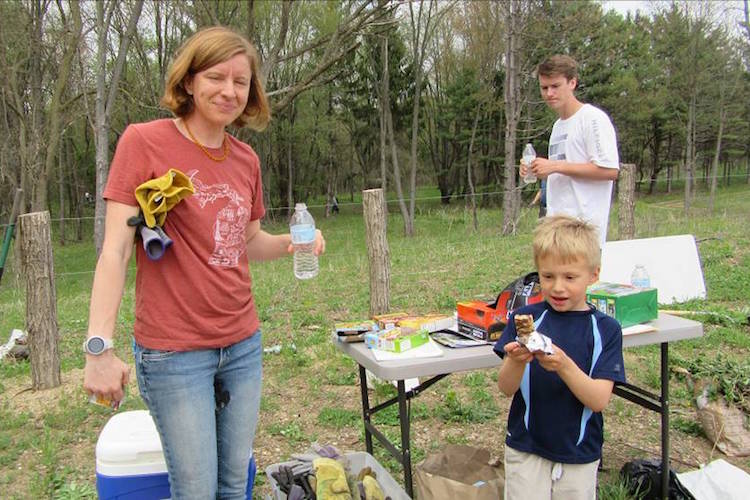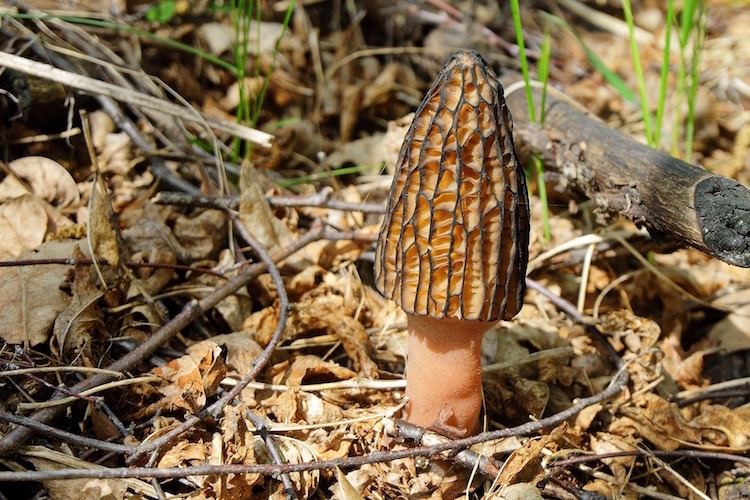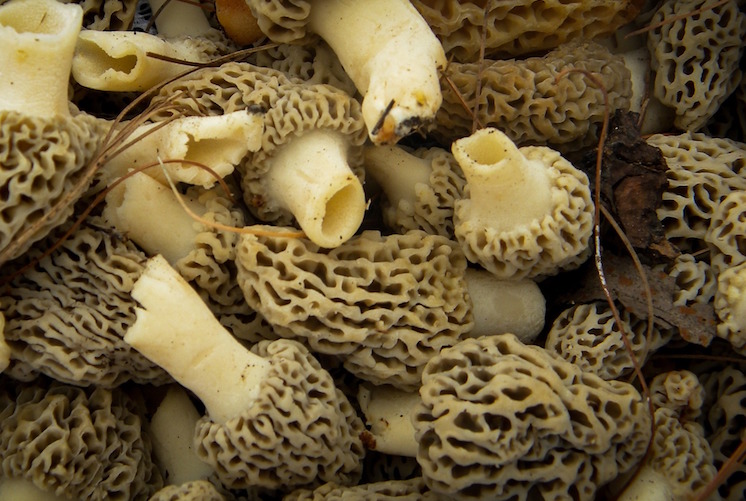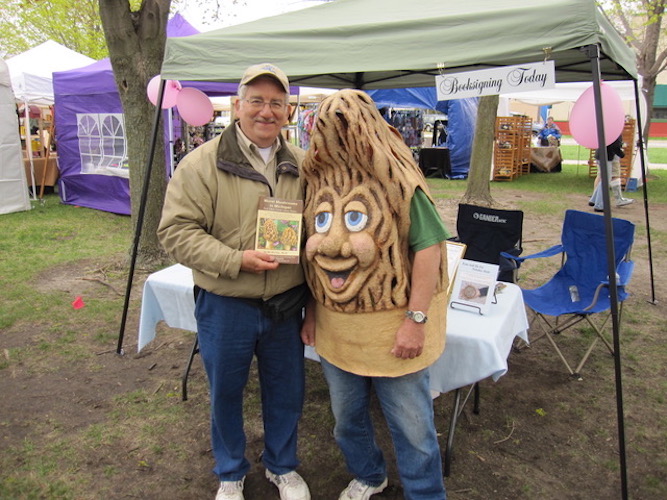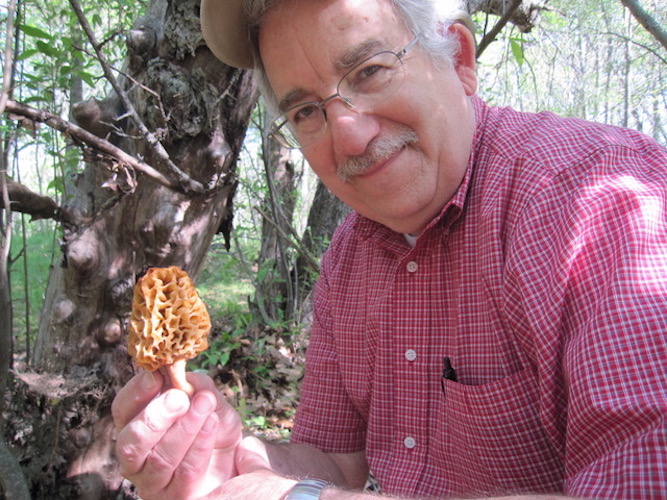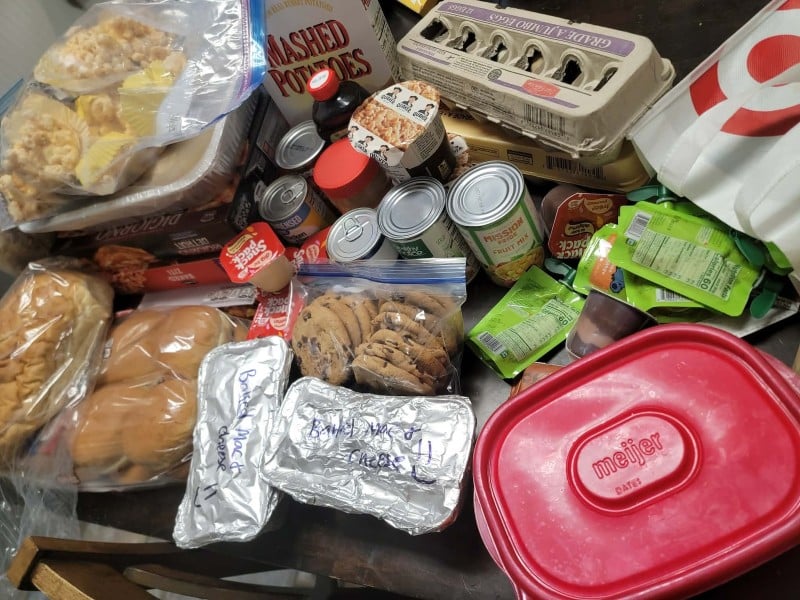Hurry before they’re gone: As season wraps up local experts talk about morels
From 6 to 76, local experts have advice on hunting the elusive morel mushroom.
River Speegle is 6 years old (“and one-quarter,” he says, importantly). Vic Eichler is 76 (can you believe it, he asks).
And though they don’t know each other, the two have something in common. They both know a lot about the mushroom of the moment. The morel.
On a recent Saturday, at a garlic mustard pull at Portman Nature Preserve, the Southwest Michigan Land Conservancy preserve in Paw Paw, River amazed those who were there to help control the invasive weed by showing them where to find morels.
“I told them I would show them where the morels were,” River recounts in an interview with Second Wave, after we were alerted to his expertise. At first, the gathering was skeptical that he could find them. “Then I showed everyone the morels and they were very excited.”
He could find the tiny morels that no one else could see. Maybe because he is so much closer to the ground, his mother, Jaimie, suggests with a smile.
River says he learned about the sometimes elusive mushroom from his mother and one of their favorite spots to look is at Bow in the Clouds, which is close to home.
Mom adds that they regularly visit other Land Conservancy sites and went to Chipman Preserve this year to learn about wildflowers. They also have enjoyed time spent at Wolf Tree Nature Trails. It turns out, River’s been learning about the outdoors since he could walk.
He’s learned about stinging nettles the hard way. And once the family’s big, shaggy dog nudged him into the water at Bow in the Clouds. After they pulled off his sopping wet clothes he came home wearing his father’s jacket so he could stay warm.
River’s learned to mimic a chickadee call (which he demonstrates, whistling). He and his father have come across what River describes as “real deer bones” left after a coyote attack. And River speaks with glee about finding puffball mushrooms that stink when you push on them to let the spores out.
The family practices “leave no trace.” That means taking nothing out of the preserve with you except “pictures and memories,” River explains. “And morels.”
So far, the morels he has found are all the white variety of the mushroom, typically found in the latter part of the short morel season. He correctly describes them as sand colored.
The most he has ever found is seven and probably 20 total in his whole life. “I counted,” he says when his mother gently questions that number.
One important lesson he’s learned is how to tell a real morel from a false one, the kind that can make you sick. “False morels are easy to tell because the top looks like a brain and the stem is not hollow. A real morel, if you pull off the top, you can look all the way through it.”
Vic Eichler has his own way of putting it. “There’s an old saying: ‘If it’s not hollow, don’t swallow.’”
Then again, he’s never had any trouble identifying the true morels from the false ones. “The deep pits and ridges, they’re just so unique.”
The description is advice he passes on willingly. Eichler has literally written the book on morels. “Morel Mushrooms in Michigan and Other Great Lake States: Where, When and How to Find Morels, How to Pick Preserve, Cook and Enjoy Morels, Detailed Nutritional Information” to be specific. It’s been in print for eight years and sells at Michigan News Agency in Kalamazoo.
The 40-page book with 12 pages of recipes and an artist’s drawings of the mushrooms has proven popular because it is the right size to take out into the field when looking for mushrooms and it’s simple without being oversimplified. A former biologist who loves to do his research, Eichler says some books have scientific details that readers don’t need when they are simply trying to identify whether a mushroom is safe to eat.
A trip up north to Petoskey to sell a book on Petoskey stones led to the book on mushrooms. While there, he and his wife went to the Jordan Inn in East Jordan to dine and met the chef. When they told him about the bookselling trip, “He said, ‘Well, it’s too bad you weren’t here a week ago. We had the 49th Annual National Morel Mushroom Festival. And I thought, ‘Really, the 49th annual? That means the next year is going to be the 50th. I think I’ll write a book about morel mushrooms for that.’ And he said, ‘Well if you do, I’ll give you a dozen or so recipes you can put in your book.’”
What comes next could be taken as almost a sign from the mushroom realms. “We were staying there along a gravel road that weekend and I found a great big beautiful morel mushroom along the road and not near any trees. And when I went back to the restaurant, I said, ‘Well, if I’m going to write a book, I want your picture in it. Why don’t you let me take a picture of you holding this?’” That picture ended up on the back cover of “Morel Mushrooms in Michigan.”
“Most of the edible mushrooms ripen in the fall, but the only mushroom that I’m a hunter of is the morel mushroom, which is a spring mushroom,” Eichler says.
“There’s another saying: ‘Morel mushrooms will suddenly appear when oak leaves are the size of a mouse’s ear.’ And that’s only a general rule. When a tree starts forming the leaves in April and May, that’s when we usually start hunting.” By the end of May, it’s often all over.
Between the shortness of the season, the thrill of the hunt, and the secrecy surrounding the location of some of the best morel growing spots, there is a whole culture that’s grown around the flavorful mushroom. There are multiple Facebook pages devoted to morel hunters showing off their bounty or bemoaning their lack of success.
“There’s a lot of mystique about finding and enjoying morel mushrooms,” Eichler says, “and one of them is people really want to keep their good hunting grounds to themselves.”
As his book says, “sharing information about the location of a fine collecting place for hundreds of morels would only bring others to the collection site and that’s information to be protected — even among good friends and family.”
Why is keeping the secret so important? “Because they’re such a treasure to enjoy,” Eichler says.
Though the 2018 season got off to a slow start, it’s been a bountiful one for the Eichlers who hunt their own property outside Three Rivers. Eichler recently collected about four pounds of morels there. Though they don’t intend to sell them (they like to eat them, too much) they are worth about $50 a pound, a price Eichler says has been constant for many years.
“Generally, there’s a lot of discussion about what kind of trees you find them under. Most everybody agrees that after a fire, like a forest fire, there will be a good picking for morel mushrooms, but also, when trees die of diseases.
“We have about 60 old apple trees on our property, so that’s probably why we find a lot here,” he says. “But also, besides elm trees and oak and apple trees and elm trees, a lot of people will swear by always finding them by aspen trees or tulip trees.
“People have their own favorite places to hunt. But the truth is, you can find them along gravel roads, you can find them in front yards. There’s no requirement for them to be growing near a tree and, that’s again, part of the mystique.”
There are certain safety rules to observe. Watch out for turkey hunters. Know where they are and make sure they know where you are.
It is best to go hunting with at least one other person, especially if you are looking in an unfamiliar area. “Usually if there are trails that people walk along, they pick the morels,” Eichler says. “So you have to go off the trails, generally, to find more mushrooms. And I’ve heard lots of stories of people who have gotten lost. They didn’t have a compass or whistle or cell phone or any other way to call for help.”
Make sure you are hunting on public property and not trespassing. Dress for the woods and check yourself for ticks after being outdoors.
A few more basics. Experienced morel hunters use mesh bags, like an onion or citrus fruit packaging for two reasons. Eichler says: “You don’t want to put them in a plastic bag because they have moisture in them and if you put them in plastic that just encourages bacteria to grow.” There is also the hope that spores from the morels will fall from the bag and help start a crop for next season.
And never pluck a morel out of the ground. Use a knife instead. Yanking the mushroom destroys the mycelium, the little structures in the ground that people think of as roots. “So we always tell people to take a knife and cut them.”
Those who find themselves with an empty bag after hours of searching, should not get discouraged. It takes practice to learn how to see the mushrooms that can be camouflaged in the leaves around them.
And River’s mom, Jamie, says sometimes the hunt can be a good excuse for being outdoors. “Everyone should go outdoors, even if they don’t find mushrooms.”
Kathy Jennings is the managing editor of Southwest Michigan’s Second Wave. She is a freelance writer and editor.
For some beautiful writing on the morel that I found while researching this story, please follow this link.

